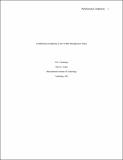| dc.contributor.author | Cummings, M. L. | |
| dc.contributor.author | Tsonis, C. | |
| dc.date.accessioned | 2014-09-24T19:18:14Z | |
| dc.date.available | 2014-09-24T19:18:14Z | |
| dc.date.issued | 2006 | |
| dc.identifier.uri | http://hdl.handle.net/1721.1/90324 | |
| dc.description.abstract | Cognitive complexity is a term that appears frequently in air traffic control (ATC) research literature, yet there is little principled investigation of the potential sources of cognitive complexity. Three distinctly different sources of
cognitive complexity are proposed which are environmental, organizational, and display. Two experiments were conducted to explore whether or not these proposed components of complexity could be effectively partitioned,
measured, and compared. The findings demonstrate that sources of complexity can be decomposed and measured and furthermore, the use of color in displays, a display design intervention meant to reduce environmental complexity, can actually contribute to it. | en_US |
| dc.description.sponsorship | This research was sponsored by the Civil Aerospace Medical Institute. | en_US |
| dc.publisher | International Journal of Aviation Psychology | en_US |
| dc.subject | Cognitive complexity | en_US |
| dc.subject | air traffic control | en_US |
| dc.title | Partitioning Complexity in Air Traffic Management Task | en_US |
| dc.type | Article | en_US |
| dc.identifier.citation | Cummings, M. L., & Tsonis, C., Partitioning Complexity in Air Traffic Management Tasks, International Journal of Aviation Psychology, Vol. 16, No. 3, Pages 277-295, 2006. | en_US |
